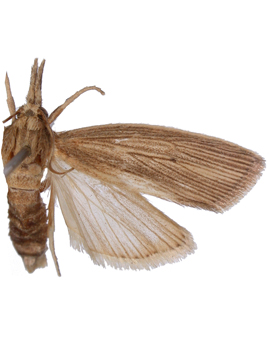Chilo sacchariphagus Bojer, [1856]; PED 5

-
Taxonomy
The holotype of Proceras sacchariphagus Bojer, 1856 is from Mauritius. The paratype is from India (Pusa).
syn. Diatraea venosatus Walker, 1863 TL Sarawak; syn. n. Bleszynski (1970: 181).
syn. Diatraea mauriciellus Walker, 1863, TL Mauritius syn. n. (Tams 1942: 67)
syn. Diatraea striatalis Snellen, 1890: TL Java, the male lectotype is in the Leiden Museum. Syn. n. of mauriciellus Walker, (Vinson 1941)
syn Chilo indicus Kapur, 1950 TL India, as a ssp. Bleszynski (1970: 163).
ssp. Argyria stramineella (Caradja, 1926: 168) from China (Shantung, Tsingtau) is smaller but similar in pattern.
Chilo pseudovenosatus Bleszynski (MS name) may be syn. (TL Philippines). -
Description
Wing length: 14mm (female) and 19mm (male). The FW is a slightly pinkish ochreous colour with the veins picked out in darker brown giving the wings a striped or ridged appearance. The HW is shining white with indistinct small dark neural spots at the margin. The thorax and abdomen are fawn brown and the legs and the large porrect palpi ochreous to white.The females have slightly squarer wings and are slightly smaller than the males. Vinson (1949: 173) illustrated the genitalia. Khoo et al. (1991) describe its biology.
-
Distribution & Habitat
Mauritius, Reunion, India, Nepal, Cambodia, Vietnam, W. Malaysia, Sabah, Sarawak, Sumatra, Java, Philippines, China (S), Taiwan, Japan.
-
Life History & Pest Status
The ‘striped sugarcane borer’. Its biology as a pest is not well known as it has often been confused with other sugar cane boring species and even some rice leaf feeders. The young larvae feed on the leaves making small ‘windows’ which enlarge as the leaves expand. Then each larva bores within a single internode leaving a large exit hole and a cavity that acts as a source of rot.
A pest of Saccharum officinarum (sugar cane) and wild cane Saccharum spp. (Poaceae). Biological control and the use of resistant varieties of cane are the best mitigation. See See Bojer (1873). Never collected at light (RTS, 1994). -
Similar spp.
no content available.
-
Unrelated Look-alikes
no content available.
-
References
Bojer, W. (1856) 'Report of the Committee on the cane borer': 1-46, 5pls..
Bojer, W. (1873) Sugar Cane, 5; 158, 302, 303, 432, 477, 534.
Caradja, A. (1926) Nach einige Worte über ostasiatiche Pyraliden und Microlepidopteren Dt. ent. Z., Iris, Dresden, 11: 155-170.
Khoo, K.C., Ooi, P.A.C. & Ho, C..T. (1991) Crop pests and their management in Malaysia. ix + 242 pp, pls., Tropical Press Sdn. Bhd., Kuala Lumpur.
Vinson, [J.] (1949) Rev. agric. Sucre Ile Maurice, 28: 173.
Walker, F. (1863 [April 18]) Crambites and Tortricites. In List Spec. Lepid. Ins. Coll. B. M., Cat. Lepid. Heterocera. 27: 1-286. -
Genitalia
no content available.
-
DNA Barcode
no content available.
-
3D Imaging
no content available.
-
Spare
no content available.
KEY TO TABS
(1) Taxonomy, (2) Description, (3) Distribution & Habitat, (4) Life History & Pest Status, (5) Similar spp., (6) Unrelated Look-alikes, (7) References, (8) Genitalia, (9) DNA Barcode, (10) 3D Imaging, (11) Spare

